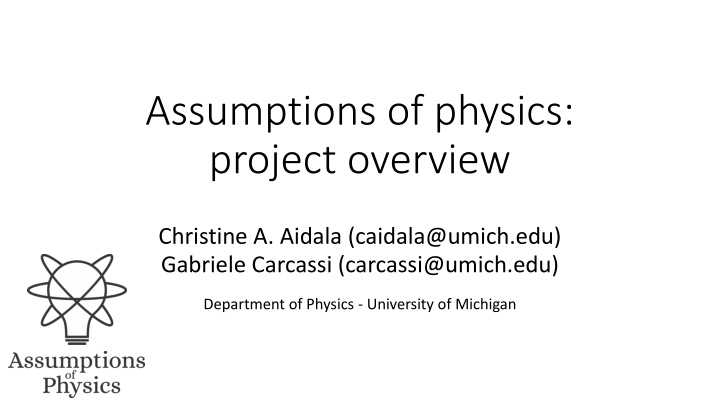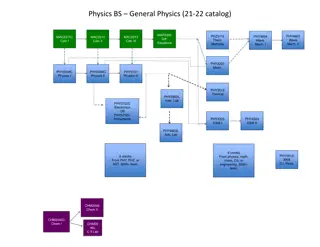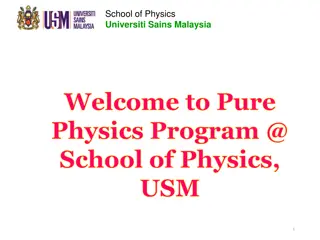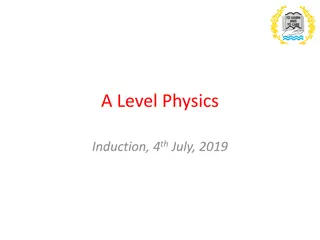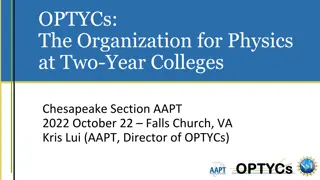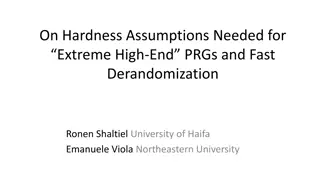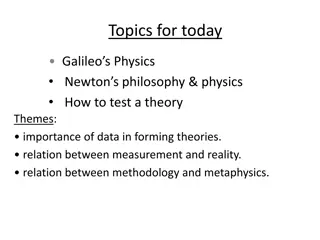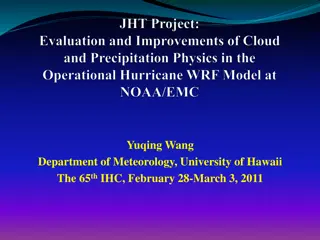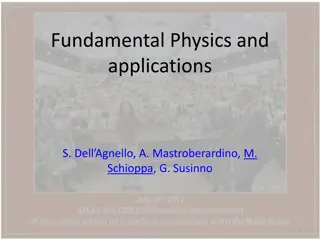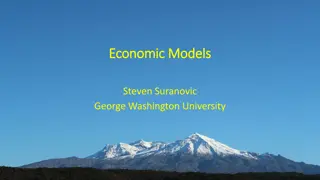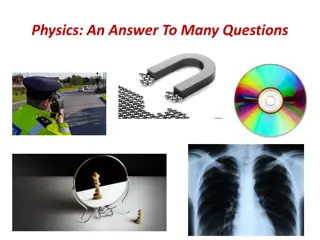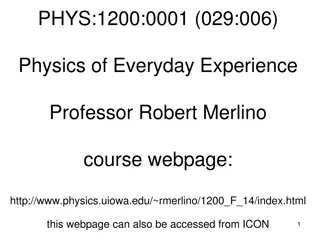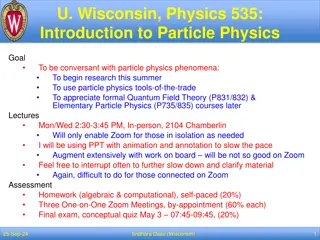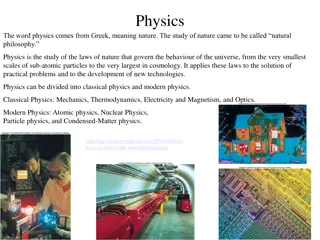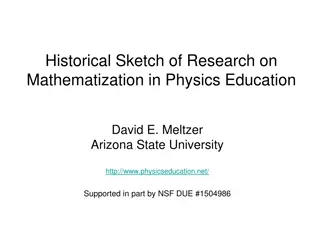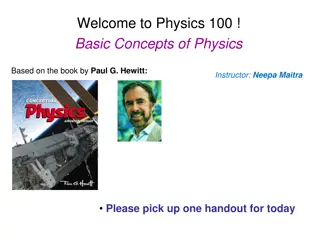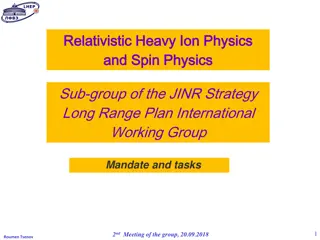Assumptions of Physics Project Overview
This project provides a unique perspective on the foundations of physics, challenging traditional approaches. It aims to develop a mathematical framework from physical principles, ensuring each mathematical object has a clear physical meaning. By exploring the consequences of failed assumptions, it seeks to inspire new ideas in physics.
Download Presentation

Please find below an Image/Link to download the presentation.
The content on the website is provided AS IS for your information and personal use only. It may not be sold, licensed, or shared on other websites without obtaining consent from the author.If you encounter any issues during the download, it is possible that the publisher has removed the file from their server.
You are allowed to download the files provided on this website for personal or commercial use, subject to the condition that they are used lawfully. All files are the property of their respective owners.
The content on the website is provided AS IS for your information and personal use only. It may not be sold, licensed, or shared on other websites without obtaining consent from the author.
E N D
Presentation Transcript
Assumptions of physics: project overview Christine A. Aidala (caidala@umich.edu) Gabriele Carcassi (carcassi@umich.edu) Department of Physics - University of Michigan
Typical view in the foundations of physics Start with the theory that describes what really happens With the most complicated and most complete description Gradually derive other theories as approximations approximation Weak interactions QED -Electromagnetism QCD Strong Interactions Electro-weak The Assumptions of Physics project does not proceed in this manner General Relativity Grand Unified Theory Theory of Everything C. A. Aidala - G. Carcassi - University of Michigan 2
Understanding fundamental structures Hamiltonian mechanics Phase space (symplectic manifold) Hamiltonian evolution Differentiable manifold Symplectic structure Manifold Differentiable structure We cannot truly understand this if we don t first understand this Locally ? Topological space I.e. Before saying there is a 50% chance to get tails we need to define what tails, chance and 50% mean Probability space Even probability spaces are not fundamental structures ?-algebra Set of points Measure What are the correct axioms and definitions on which to build scientific theories? How can they be justified? C. A. Aidala - G. Carcassi - University of Michigan 3
Space of the well-posed scientific theories Physical theories Specializations of the general theory under the different assumptions Unitary evolution Hamiltonian mechanics Quantum state-space Classical phase-space Infinitesimal reducibility Determinism/ reversibility Assumptions Irreducibility States and processes General theory Informational granularity Basic requirements and definitions valid in all theories Experimental verifiability C. A. Aidala - G. Carcassi - University of Michigan 4
Assumptions of Physics Objectives: Develop a mathematical framework that can serve as the foundation for all scientific theories (i.e. a mathematical theory about scientific theories) Start from physical principles and assumptions and derive the math (not start from the math and add the physics later through an interpretation ) Each mathematical object must have a clear physical meaning (no object is unphysical, can read math proofs as logical arguments on the physics) Construct concepts and tools that span different disciplines (nature does not care about divisions in fields of knowledge) Explore what happens when the assumptions fail, possibly leading to new physics ideas C. A. Aidala - G. Carcassi - University of Michigan 5
The logic of experimental verifiability C. A. Aidala - G. Carcassi - University of Michigan 6
Science deals with well-posed sets of assertions (non-contradictory) that have a single truth value (universal) that can be defined/ascertained experimentally (evidence based) Verifiable statements: assertions that can be experimentally verified in a finite time Counterexamples: Chocolate tastes good (not universal) It is immoral to kill one person to save ten (not universal and/or evidence-based) The number 4 is prime (not evidence-based) This statement is false (not non-contradictory) The mass of the photon is exactly 0 eV (not verifiable due to infinite precision) Examples: The mass of the photon is less than 10 13 eV If the height of the mercury column is between 24 and 25 millimeters then its temperature is between 24 and 25 Celsius If I take 2 0.01 Kg of Sodium-24 and wait 15 0.01 hours there will be only 1 0.01 Kg left We have to keep in mind that the meaning of the statements, their relationships and what truth values are allowed depends on context (e.g. premise, theory, etc ) The mass of the electron is 511 0.5 KeV When measuring the mass, it is a verifiable hypothesis When performing particle identification, it is assumed to be true C. A. Aidala - G. Carcassi - University of Michigan 7
Axioms of logic ? ?? T ?? T ?? F ? ?? T F T T F F ? ??,??,?? ?? T ?? T ?? F T ?? T T F T T F F F C. A. Aidala - G. Carcassi - University of Michigan 8
Axioms of verifiability ? ?1 Test Result ?v SUCCESS (in finite time) T FAILURE (in finite time) F UNDEFINED ?1 experimental test ? ?1 ?2 ?3 ?? ?=? All tests must succeed ?1 ?2 ?3 ?? ?=1 One successful test is sufficient C. A. Aidala - G. Carcassi - University of Michigan 9
Properties of the logic system Different algebras for the different types of statements ?? ?? ? (Different) notions of equivalences Are the same statement This animal is a bird = Questo animale e un uccello This animal is a bird This animal has feathers truth( This animal is a bird ) = truth( That animal is a mammal ) Always have the same truth Happen to have the same truth C. A. Aidala - G. Carcassi - University of Michigan 10
Experimental domains (scientific models) From them generate all verifiable statements (close under finite AND countable OR) Generate all meaningful predictions (close under negation as well) Start with a countable set of verifiable statements ?? Basis ? Experimental domain ?? Theoretical domain a Fill in all possible assignments ?? ?? ?? ??= ?? ?? ??= ?? ?? ??= ?? ?? ??= ?? F F F F F T T Possibilities? ?? The points of the space (the possibilities, the distinguishable cases) are not given a priori but are constructed from the chosen verifiable statements F T F T F F T T T F T F T F For each possible assignment we have a theoretical statement that is true only in that case. We call these statements possibilities of the domain. ? = ?? ?? ?? C. A. Aidala - G. Carcassi - University of Michigan 11
Topologies and ?-algebras Each column (statement) is also a set of possibilities Finite AND and countable OR become finite intersection and countable union Negation and countable AND become complement and countable union ? = ? ? ? Basis ? Experimental domain ?? Theoretical domain ?? Topologies (needed for manifold/geometr ic spaces) and ?- algebras (needed for integration and probability spaces) naturally arise from requiring experimental verifiability ?? ?? ?? ??= ?? ?? ??= ?? ?? ??= ?? ?? ??= ?? F F F F F T T Possibilities? F T F T F F T T T F T F T F The theoretical domain ?? induces a (Borel) ?-algebra The experimental domain ?? induces a topology on the possibilities ?. C. A. Aidala - G. Carcassi - University of Michigan 12
Maximum cardinality of distinguishable cases Set of distinguishable cases Test results for countable basis Correspond to binary expansion FTFFFTTTFTFTT TFFTTFTTFFFTF FTFFFTTFTFFTF FTTFTFTTFTFFT 0.0100011101011 0.1001101100010 0.0100011010010 0.0110101101001 1 Correspondence to binary sequence 0100011101011 1001101100010 0100011010010 0110101101001 ? ? | | 0 Sets with greater cardinality (e.g. the set of all discontinuous functions from to ) cannot represent physical objects Issues about higher infinities (e.g. large cardinals) are not relevant, but those surrounding the continuum hypothesis may be C. A. Aidala - G. Carcassi - University of Michigan 13
Topologies and ?-algebras ???(?) corresponds to the verifiable part of a statement ?1 Test Result All definitions and all proofs about these structures have precise physical meaning in this context SUCCESS (in finite time) T ?? corresponds to the undecidable part of a statement UNDEFINED UNDEFINED F FAILURE (in finite time) ???(?) corresponds to the falsifiable part of a statement If ? ?is an open set then ? is in ? is a verifiable statement (e.g. the mass of the electron is 511 0.5 KeV ) Topologies and ?-algebras each capture part of the formal structure If V ?is a closed set then ? is in ? is a falsifiable statement (e.g. the mass of the electron is exactly 511 KeV ) If ? ? is a Borel set then ? is in A is a theoretical statement: a test can be created, though we have no guarantee of termination (e.g. the mass of the electron in KeV is a rational number is undecidable, the test will never terminate) For us, they are part of a single unified structure C. A. Aidala - G. Carcassi - University of Michigan 14
Physical meaning of separation axioms All topologies are Kolmogorov (i.e. ?0) Possibilities are experimentally well-defined i.e. possibilities constructible from a base by countable AND/OR and NOT (singletons in the ?-algebra) The topology is ?1 if all possibilities are approximately verifiable Possibilities are the limit of a sequence of verifiable statements i.e. possibilities are the countable conjunction of verifiable statements The topology is Hausdorff (i.e. ?2) if all possibilities are pairwise experimentally distinguishable Given two possibilities, we can find a test that confirms one and excludes the other i.e. for any ?1,?2 ? there is a statement ? ?? such that ?1 ???(?) and ?2 ???(?) ? ?1 ?2 Test Result T SUCCESS (in finite time) T UNDEFINED F UNDEFINED F F FAILURE (in finite time) T C. A. Aidala - G. Carcassi - University of Michigan 15
Examples Standard topology on integers Decidable domain (all statements are decidable) Discrete topology (every set is clopen); topology and ?-algebra both coincide with the power set 0 1 2 3 4 5 6 Standard topology on the reals Finite precision measurements (open intervals are verifiable) Topology generated by open intervals (coincides with order and metric topology); separable, complete, connected (no clopen sets except full and empty set); ?-algebra is the Borel algebra (strict subset of power set) C. A. Aidala - G. Carcassi - University of Michigan 16
Examples Does extra-terrestrial life exist? Semi-decidable question Topology , ? , ?,? is strictly ?0; ?-algebra is the power set Y N How many leptons (electron-like particles) are there? (through direct observation) Can only measure lower bound (e.g. there are at least ? ) Topology contains empty set and ?,? + 1,? + 2, for all ?; strictly ?0; ?-algebra is the power set 6 5 4 3 2 1 0 C. A. Aidala - G. Carcassi - University of Michigan 17
Inference/causal relationships and continuity An inference relationship is a map ?:?? ?? such that ? ? ? ?? ?? e.g. the water temperature is between 0 and 0.52 Celsius or between 7.6 and 9.12 Celsius e.g. the water density is between 999.8 and 999.9 kg/m3 ? ? e.g. the water temperature is exactly 4 Celsius e.g. the water density is exactly 1 kg/m3 A causal relationship is a map ?:? ? such that ? ? ? Two general and important results: 1) Two domains admit an inference relationship if and only if they admit a causal relationship 2) The causal relationship must be a continuous map in the natural topology C. A. Aidala - G. Carcassi - University of Michigan 18
Takeaway A science first formal structure is possible Physically meaningful, mathematically precise, philosophically consistent Precise science/math dictionary Well-behaved mathematical objects are really well-defined physical objects Experimental verifiability is the basis for scientifically well-defined objects Topologies and ?-algebras arise from scientific epistemological requirements, not from ontological features of the universe Most other structures used in science (differential geometry, measure theory, probability theory, Lie algebras, ) are based on topologies and ?-algebras No progress in the foundations of physics is possible without proper understanding of these connections C. A. Aidala - G. Carcassi - University of Michigan 19
The assumptions of classical mechanics C. A. Aidala - G. Carcassi - University of Michigan 20
Assumption of infinitesimal reducibility The system is reducible to its parts: giving the state of the whole is equivalent to giving the state of the parts. The system can be subdivided indefinitely. time ? is the state of the infinitesimal parts (i.e. particles) ? ? is a set of possible states for the particles ? ? is a set of possible amounts of materials We ll have statements of the form the amount of material found in ? is within the range ? C. A. Aidala - G. Carcassi - University of Michigan 21
Density over states The state of the whole is given by a distribution over the state of the infinitesimal parts (i.e. particles) ?:? ??? ? Density depends on the state; unit is [amount]/[states] Fraction of the system in a region ? This presents a puzzle: ? ? ?? = ? ?? ? ??= ? ?? ??= ???? Under a change of variables ??? ? ??? ?? = ? ? ?? ? ? ?? ? ??= we have How can ? both change as a density and be an invariant? C. A. Aidala - G. Carcassi - University of Michigan 22
Units When we write ??(?)??, ? is expressed in units of [amount]/[states] When we write ?? ?????, ? is expressed in units of [amount]/[?1] [??] It seems we need to characterize the role of units The units of some variables depend on the units of others E.g. the unit for velocity ? = ??/?? along a direction ? depends on the unit for distance along that direction and time; the unit for entropy ?? = ??/? depends on the unit for energy and temperature Within the state variables ??, we identify the unit variables ?? as those that define the unit system A change of units ??= ??(??) must induce a unique transformation ??= ???? on all variables C. A. Aidala - G. Carcassi - University of Michigan 23
Phase space (symplectic manifold) The structure of phase space is exactly what is needed to define invariant densities over particle states ? = 100 ??/? ? ? = 0.01 ?? 1 ? = 1 ? 1 1 1 The product ? ? is invariant ? = 100 ?? ? = 1 ? For a single degree of freedom (i.e. one independent unit variable) ?? = ???? = ? ?? ? For ? independent degrees of freedom ?? = ???????= ?? ??? ?? Canonical variables are those that allow us to express density in the correct units over each independent degree of freedom C. A. Aidala - G. Carcassi - University of Michigan 24
Assumption of deterministic and reversible evolution Given the state of the system at one time, we are able to predict the state at future times (determinism) and reconstruct (reversibility) the state at past times. time Dynamical system ?? ??+ t ? Not enough! time All and only the particles from ?? must be found in ??+ ?: ? ??,? = ? ??+ ?,? + ? Independent degrees of freedom must be mapped to independent degrees of freedom Hamiltonian mechanics (symplectic structure must be preserved) C. A. Aidala - G. Carcassi - University of Michigan 25
Hamiltonian mechanics for one degree of freedom ? ?? ??,?? ??,?? Displacement along the trajectory ? = ?? ??? ? = 0 Deterministic and reversible: flux over a closed surface is zero ? = ????( ?) ? Because ?? ??= 1 we can choose a gauge such that: ? ? = ?,0, ? ?,? This recovers Hamilton s equations ?? ??,?? ??,?? ?? ??, ?? ??,1 = ????( ?) ? = = ?? C. A. Aidala - G. Carcassi - University of Michigan 26
Understanding Hamiltonian mechanics Hamiltonian mechanics Phase space (symplectic manifold) Hamiltonian evolution Differentiable manifold Symplectic structure Manifold Differentiable structure Locally ? Topological space The evolution is deterministic and reversible The composite system is a density that is invariant under change of units Particle states are experimentally distinguishable using continuous variables Each mathematical structure is linked to a specific physical requirement C. A. Aidala - G. Carcassi - University of Michigan 27
Possible contributions C. A. Aidala - G. Carcassi - University of Michigan 28
Bare minima Project is very interdisciplinary and requires knowledge from different areas of math, physics and engineering We want to create a series of short (12-16 pages) articles that give the basic definitions and main results of each field: the bare minimum one needs to know E.g. Set theory: https://assumptionsofphysics.org/resources/bareminima/SetTheory.pdf Hourly work C. A. Aidala - G. Carcassi - University of Michigan 29
Other small tasks (hourly work) There are a number of smaller questions it would be nice to settle Is every Heyting algebra embeddable in a Boolean algebra? To make sure we are not ruling anything out Finalize last few details in our basic structures Find the correct morphism that gives us the right product, Study a Gaussian peak under linear Hamiltonian flow To generalize the classical uncertainty relationship Special relativity from densities Look for hints of general relativity in the extended phase space See if the link between symplectic form, metric and vector potential leads to relationships to the curvature Characterize quantum projections as processes with constraints that maximize entropy Analyze the relationship between linearity of mixed (classical mixtures) and pure states (quantum superposition) in quantum mechanics Can superposition be fully characterized by aliasing of mixed states? Some of these questions may be already solved in the literature, some may be hard Helping to formalize/organize the questions is also useful C. A. Aidala - G. Carcassi - University of Michigan 30
A new foundation for measures and geometry We saw that topological and ?-algebraic structures come from experimental verifiability: how do we recover the rest? Note that measures and metrics are used to give a size to sets In physics, conceptually, we start with the ability to compare sizes (this is bigger than this); we then construct measurement scales to give numerical values The idea is to provide a foundation for measure theory and geometry in the same way: we have the lattice of all possible descriptions (our ?-algebra); we add a preorder that tells us whether one description is finer (i.e. more refined) than another; pick a unit and construct a measure that respects the order and that is linear under disjoint addition The goal is to find a set of sufficient physically justifiable conditions for which such measures can be constructed https://assumptionsofphysics.org/resources/blueprints/InformationGranularity.pdf For preliminary work, see https://assumptionsofphysics.org/resources/blueprints/InformationGranularity.pdf C. A. Aidala - G. Carcassi - University of Michigan 31
Physical entropy as counting evolutions The idea is to define how to count (in a measure theoretic sense) the possible evolutions of a system; we define the process entropy as the logarithm of that count State entropy becomes the process entropy associated to all possible evolutions that pass through that state at that time Equilibrium states concentrate the evolutions and therefore they maximize the process entropy The goal is, with similar considerations, to rederive the basic laws of thermodynamics in the most possible general setting, and recover the standard formula for entropy (i.e. Gibbs, log of count of states, ) in specific cases For preliminary work, see https://assumptionsofphysics.org/resources/blueprints/ProcessEntropy.pdf ?0 ?1 C. A. Aidala - G. Carcassi - University of Michigan 32
Other bigger tasks Find a reformulation of quantum mechanics that fits better in the framework Projective spaces? Use mixed states as prime object? Algebraic? Find a set of physical motivations to introduce differentiability and differential forms General idea is to describe linear quantities associated to k-dimensional submanifolds (rough ideas in Bachelor s thesis https://assumptionsofphysics.org/Thesis-Johnson- DifferentialGeometry.pdf ) C. A. Aidala - G. Carcassi - University of Michigan 33
Final thought Prima dovete capire le cose nel piccolo, e poi generalizzare First you have to understand the simple case, and then generalize Se non avete capito nel piccolo, capirete ancora meno quando generalizzate If you haven t understood the simple case, you will understand even less when you generalize C. A. Aidala - G. Carcassi - University of Michigan 34
